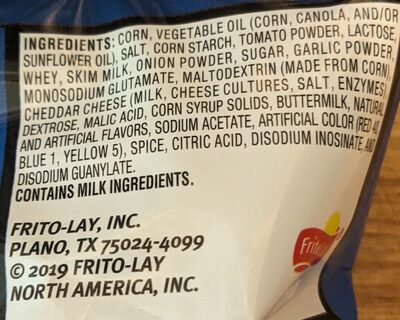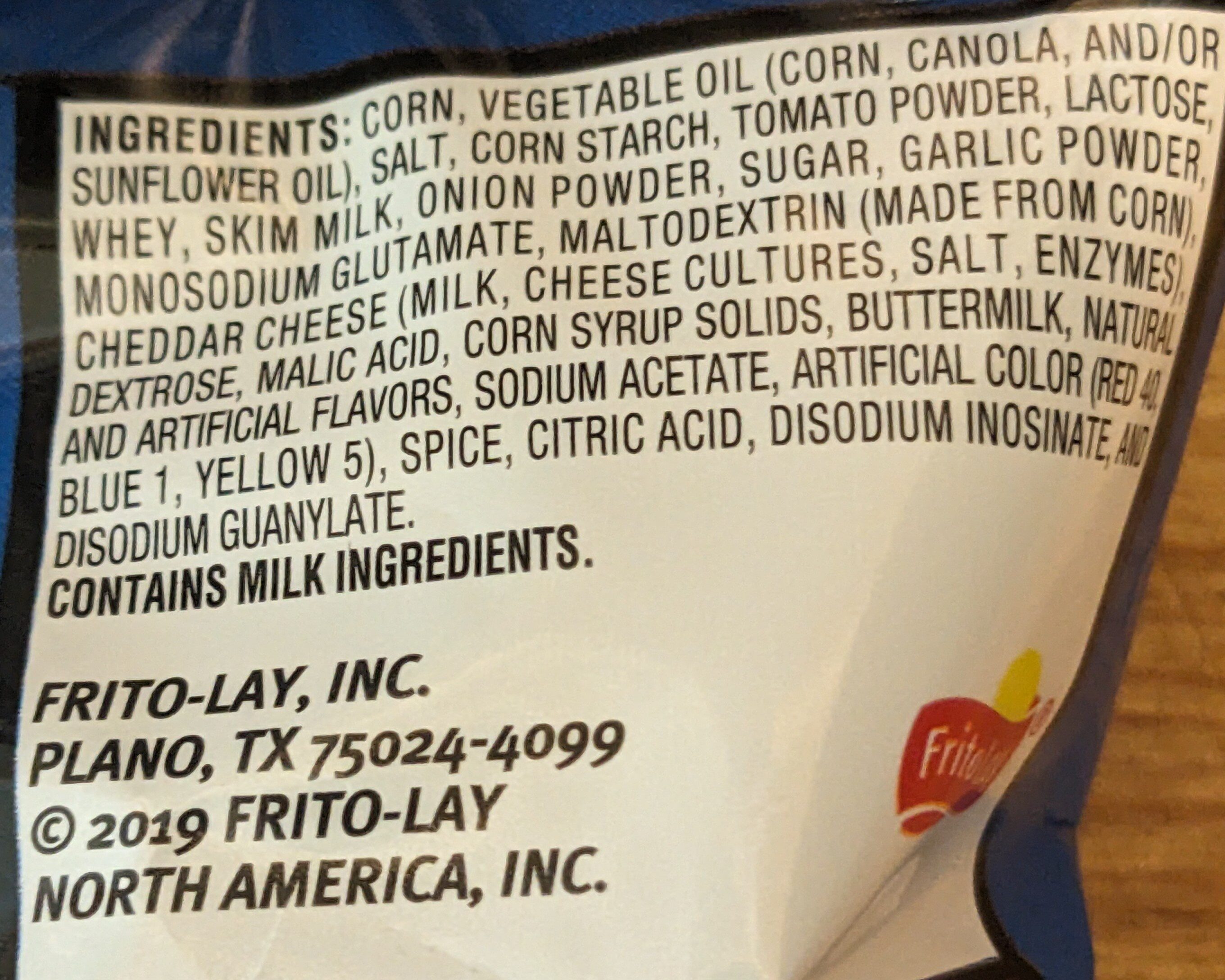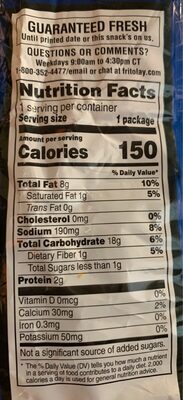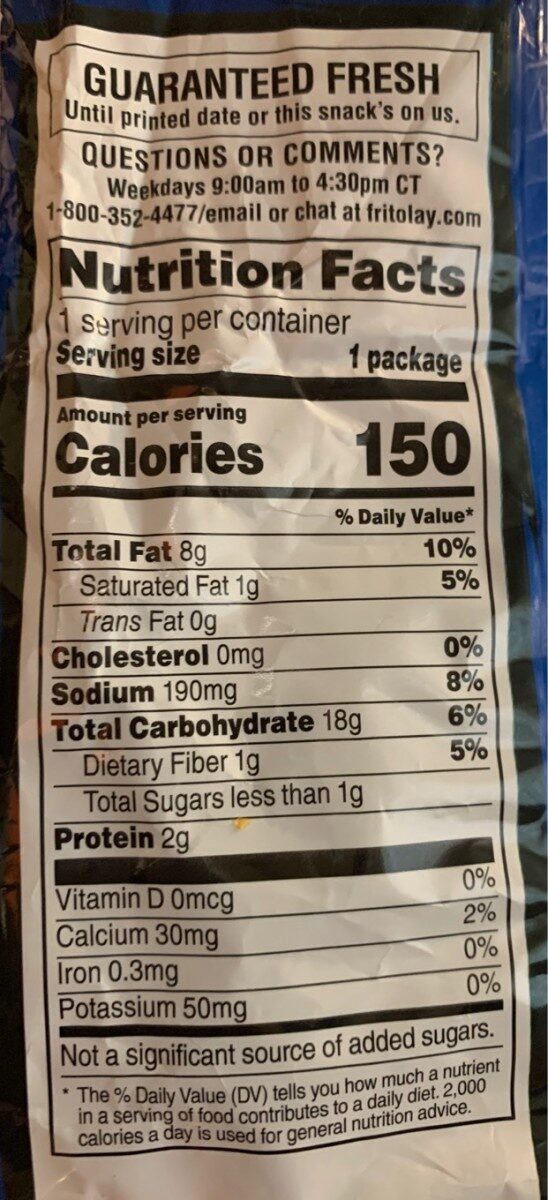Help us make food transparency the norm!
As a non-profit organization, we depend on your donations to continue informing consumers around the world about what they eat.
The food revolution starts with you!
Cool Ranch Doritos - 1 oz (28.3 g)
Cool Ranch Doritos - 1 oz (28.3 g)
This product page is not complete. You can help to complete it by editing it and adding more data from the photos we have, or by taking more photos using the app for Android or iPhone/iPad. Thank you!
×
Barcode: 0028400091510 (EAN / EAN-13) 028400091510 (UPC / UPC-A)
Common name: Tortilla Chips
Quantity: 1 oz (28.3 g)
Brands: Doritos
Categories: Snacks, Salty snacks, Appetizers, Chips and fries, Crisps, Corn chips
Labels, certifications, awards: Contains milk
Countries where sold: United States
Matching with your preferences
Health
Ingredients
-
36 ingredients
CORN, VEGETABLE OIL (CORN OIL, CANOLA OIL, SUNFLOWER OIL), SALT, CORN STARCH, TOMATO POWDER, LACTOSE, WHEY, SKIM MILK, ONION POWDER, SUGAR, GARLIC POWDER, MONOSODIUM GLUTAMATE, MALTODEXTRIN (CORN), CHEDDAR CHEESE (MILK, CHEESE CULTURES, SALT, ENZYMES), DEXTROSE, MALIC ACID, CORN SYRUP SOLIDS, BUTTERMILK, NATURAL AND ARTIFICIAL FLAVORS, SODIUM ACETATE, ARTIFICIAL COLOR (RED 40, BLUE 1, YELLOW 5), SPICE, CITRIC ACID, DISODIUM INOSINATE, DISODIUM GUANYLATE.Allergens: Milk
Food processing
-
Ultra processed foods
Elements that indicate the product is in the 4 - Ultra processed food and drink products group:
- Additive: E102 - Tartrazine
- Additive: E129 - Allura red
- Additive: E133 - Brilliant blue FCF
- Additive: E621 - Monosodium glutamate
- Additive: E627 - Disodium guanylate
- Additive: E631 - Disodium inosinate
- Ingredient: Colour
- Ingredient: Dextrose
- Ingredient: Flavouring
- Ingredient: Glucose
- Ingredient: Lactose
- Ingredient: Maltodextrin
- Ingredient: Whey
Food products are classified into 4 groups according to their degree of processing:
- Unprocessed or minimally processed foods
- Processed culinary ingredients
- Processed foods
- Ultra processed foods
The determination of the group is based on the category of the product and on the ingredients it contains.
Additives
-
E102 - Tartrazine
Tartrazine: Tartrazine is a synthetic lemon yellow azo dye primarily used as a food coloring. It is also known as E number E102, C.I. 19140, FD&C Yellow 5, Acid Yellow 23, Food Yellow 4, and trisodium 1--4-sulfonatophenyl--4--4-sulfonatophenylazo--5-pyrazolone-3-carboxylate-.Tartrazine is a commonly used color all over the world, mainly for yellow, and can also be used with Brilliant Blue FCF -FD&C Blue 1, E133- or Green S -E142- to produce various green shades.Source: Wikipedia
-
E129 - Allura red
Allura Red AC: Allura Red AC is a red azo dye that goes by several names, including FD&C Red 40. It is used as a food dye and has the E number E129. It is usually supplied as its red sodium salt, but can also be used as the calcium and potassium salts. These salts are soluble in water. In solution, its maximum absorbance lies at about 504 nm.Source: Wikipedia
-
E133 - Brilliant blue FCF
Brilliant Blue FCF: Brilliant Blue FCF -Blue 1- is an organic compound classified as a triarylmethane dye and a blue azo dye, reflecting its chemical structure. Known under various commercial names, it is a colorant for foods and other substances. It is denoted by E number E133 and has a color index of 42090. It has the appearance of a blue powder. It is soluble in water, and the solution has a maximum absorption at about 628 nanometers.Source: Wikipedia
-
E262 - Sodium acetates
Sodium acetate: Sodium acetate, CH3COONa, also abbreviated NaOAc, is the sodium salt of acetic acid. This colorless deliquescent salt has a wide range of uses.Source: Wikipedia
-
E262i - Sodium acetate
Sodium acetate: Sodium acetate, CH3COONa, also abbreviated NaOAc, is the sodium salt of acetic acid. This colorless deliquescent salt has a wide range of uses.Source: Wikipedia
-
E296 - Malic acid
Malic acid: Malic acid is an organic compound with the molecular formula C4H6O5. It is a dicarboxylic acid that is made by all living organisms, contributes to the pleasantly sour taste of fruits, and is used as a food additive. Malic acid has two stereoisomeric forms -L- and D-enantiomers-, though only the L-isomer exists naturally. The salts and esters of malic acid are known as malates. The malate anion is an intermediate in the citric acid cycle.Source: Wikipedia
-
E330 - Citric acid
Citric acid is a natural organic acid found in citrus fruits such as lemons, oranges, and limes.
It is widely used in the food industry as a flavor enhancer, acidulant, and preservative due to its tart and refreshing taste.
Citric acid is safe for consumption when used in moderation and is considered a generally recognized as safe (GRAS) food additive by regulatory agencies worldwide.
-
E621 - Monosodium glutamate
Monosodium glutamate: Monosodium glutamate -MSG, also known as sodium glutamate- is the sodium salt of glutamic acid, one of the most abundant naturally occurring non-essential amino acids. Glutamic acid is found naturally in tomatoes, grapes, cheese, mushrooms and other foods.MSG is used in the food industry as a flavor enhancer with an umami taste that intensifies the meaty, savory flavor of food, as naturally occurring glutamate does in foods such as stews and meat soups. It was first prepared in 1908 by Japanese biochemist Kikunae Ikeda, who was trying to isolate and duplicate the savory taste of kombu, an edible seaweed used as a base for many Japanese soups. MSG as a flavor enhancer balances, blends, and rounds the perception of other tastes.The U.S. Food and Drug Administration has given MSG its generally recognized as safe -GRAS- designation. A popular belief is that large doses of MSG can cause headaches and other feelings of discomfort, known as "Chinese restaurant syndrome," but double-blind tests fail to find evidence of such a reaction. The European Union classifies it as a food additive permitted in certain foods and subject to quantitative limits. MSG has the HS code 29224220 and the E number E621.Source: Wikipedia
-
E627 - Disodium guanylate
Disodium guanylate: Disodium guanylate, also known as sodium 5'-guanylate and disodium 5'-guanylate, is a natural sodium salt of the flavor enhancing nucleotide guanosine monophosphate -GMP-. Disodium guanylate is a food additive with the E number E627. It is commonly used in conjunction with glutamic acid. As it is a fairly expensive additive, it is not used independently of glutamic acid; if disodium guanylate is present in a list of ingredients but MSG does not appear to be, it is likely that glutamic acid is provided as part of another ingredient such as a processed soy protein complex. It is often added to foods in conjunction with disodium inosinate; the combination is known as disodium 5'-ribonucleotides. Disodium guanylate is produced from dried seaweed and is often added to instant noodles, potato chips and other snacks, savory rice, tinned vegetables, cured meats, and packaged soup.Source: Wikipedia
-
E631 - Disodium inosinate
Disodium inosinate: Disodium inosinate -E631- is the disodium salt of inosinic acid with the chemical formula C10H11N4Na2O8P. It is used as a food additive and often found in instant noodles, potato chips, and a variety of other snacks. Although it can be obtained from bacterial fermentation of sugars, it is often commercially prepared from animal sources.Source: Wikipedia
Ingredients analysis
-
Palm oil free
No ingredients containing palm oil detected
-
Non-vegan
Non-vegan ingredients: Lactose, Whey, Skimmed milk, Cheddar, Milk, Buttermilk
-
Maybe vegetarian
Ingredients that may not be vegetarian: Whey, Enzyme, Natural and artificial flavouring, E631, E627
-
Details of the analysis of the ingredients
en: CORN, VEGETABLE OIL (CORN OIL, CANOLA OIL, SUNFLOWER OIL), SALT, CORN STARCH, TOMATO, LACTOSE, WHEY, SKIM MILK, ONION, SUGAR, GARLIC, MONOSODIUM GLUTAMATE, MALTODEXTRIN (CORN), CHEDDAR CHEESE (MILK, CHEESE CULTURES, SALT, ENZYMES), DEXTROSE, MALIC ACID, CORN SYRUP SOLIDS, BUTTERMILK, NATURAL and ARTIFICIAL FLAVORS, SODIUM ACETATE, ARTIFICIAL COLOR (RED 40, BLUE 1, YELLOW 5), SPICE, CITRIC ACID, DISODIUM INOSINATE, DISODIUM GUANYLATE- CORN -> en:corn - vegan: yes - vegetarian: yes - ciqual_food_code: 9200 - percent_min: 11.36 - percent_max: 100
- VEGETABLE OIL -> en:vegetable-oil - vegan: yes - vegetarian: yes - from_palm_oil: maybe - percent_min: 0 - percent_max: 50
- CORN OIL -> en:corn-oil - vegan: yes - vegetarian: yes - from_palm_oil: no - ciqual_food_code: 17190 - percent_min: 0 - percent_max: 50
- CANOLA OIL -> en:canola-oil - vegan: yes - vegetarian: yes - from_palm_oil: no - percent_min: 0 - percent_max: 25
- SUNFLOWER OIL -> en:sunflower-oil - vegan: yes - vegetarian: yes - from_palm_oil: no - ciqual_food_code: 17440 - percent_min: 0 - percent_max: 16.6666666666667
- SALT -> en:salt - vegan: yes - vegetarian: yes - ciqual_food_code: 11058 - percent_min: 0 - percent_max: 1.68
- CORN STARCH -> en:corn-starch - vegan: yes - vegetarian: yes - ciqual_food_code: 9510 - percent_min: 0 - percent_max: 1.68
- TOMATO -> en:tomato - vegan: yes - vegetarian: yes - ciqual_food_code: 20047 - percent_min: 0 - percent_max: 1.68
- LACTOSE -> en:lactose - vegan: no - vegetarian: yes - percent_min: 0 - percent_max: 1.68
- WHEY -> en:whey - vegan: no - vegetarian: maybe - percent_min: 0 - percent_max: 1.68
- SKIM MILK -> en:skimmed-milk - vegan: no - vegetarian: yes - ciqual_proxy_food_code: 19051 - percent_min: 0 - percent_max: 1.68
- ONION -> en:onion - vegan: yes - vegetarian: yes - ciqual_food_code: 20034 - percent_min: 0 - percent_max: 1.68
- SUGAR -> en:sugar - vegan: yes - vegetarian: yes - ciqual_proxy_food_code: 31016 - percent_min: 0 - percent_max: 1.68
- GARLIC -> en:garlic - vegan: yes - vegetarian: yes - ciqual_food_code: 11000 - percent_min: 0 - percent_max: 1.68
- MONOSODIUM GLUTAMATE -> en:e621 - vegan: yes - vegetarian: yes - percent_min: 0 - percent_max: 1.68
- MALTODEXTRIN -> en:maltodextrin - vegan: yes - vegetarian: yes - percent_min: 0 - percent_max: 1.68
- CORN -> en:corn - vegan: yes - vegetarian: yes - ciqual_food_code: 9200 - percent_min: 0 - percent_max: 1.68
- CHEDDAR CHEESE -> en:cheddar - vegan: no - vegetarian: maybe - ciqual_food_code: 12726 - percent_min: 0 - percent_max: 1.68
- MILK -> en:milk - vegan: no - vegetarian: yes - ciqual_proxy_food_code: 19051 - percent_min: 0 - percent_max: 1.68
- CHEESE CULTURES -> en:lactic-ferments - vegan: maybe - vegetarian: yes - percent_min: 0 - percent_max: 0.84
- SALT -> en:salt - vegan: yes - vegetarian: yes - ciqual_food_code: 11058 - percent_min: 0 - percent_max: 0.56
- ENZYMES -> en:enzyme - vegan: maybe - vegetarian: maybe - percent_min: 0 - percent_max: 0.42
- DEXTROSE -> en:dextrose - vegan: yes - vegetarian: yes - ciqual_proxy_food_code: 31016 - percent_min: 0 - percent_max: 1.68
- MALIC ACID -> en:e296 - vegan: yes - vegetarian: yes - percent_min: 0 - percent_max: 1.68
- CORN SYRUP SOLIDS -> en:corn-syrup-solids - vegan: yes - vegetarian: yes - ciqual_proxy_food_code: 31089 - percent_min: 0 - percent_max: 1.68
- BUTTERMILK -> en:buttermilk - vegan: no - vegetarian: yes - ciqual_food_code: 19801 - percent_min: 0 - percent_max: 1.68
- NATURAL and ARTIFICIAL FLAVORS -> en:natural-and-artificial-flavouring - vegan: maybe - vegetarian: maybe - percent_min: 0 - percent_max: 1.68
- SODIUM ACETATE -> en:e262i - vegan: yes - vegetarian: yes - percent_min: 0 - percent_max: 1.68
- ARTIFICIAL COLOR -> en:colour - percent_min: 0 - percent_max: 1.68
- RED 40 -> en:e129 - vegan: yes - vegetarian: yes - percent_min: 0 - percent_max: 1.68
- BLUE 1 -> en:e133 - vegan: yes - vegetarian: yes - percent_min: 0 - percent_max: 0.84
- YELLOW 5 -> en:e102 - vegan: yes - vegetarian: yes - percent_min: 0 - percent_max: 0.56
- SPICE -> en:spice - vegan: yes - vegetarian: yes - percent_min: 0 - percent_max: 1.68
- CITRIC ACID -> en:e330 - vegan: yes - vegetarian: yes - percent_min: 0 - percent_max: 1.68
- DISODIUM INOSINATE -> en:e631 - vegan: maybe - vegetarian: maybe - percent_min: 0 - percent_max: 1.68
- DISODIUM GUANYLATE -> en:e627 - vegan: maybe - vegetarian: maybe - percent_min: 0 - percent_max: 1.68
Nutrition
-
Poor nutritional quality
This product is not considered a beverage for the calculation of the Nutri-Score.
Positive points: 3
- Proteins: 4 / 5 (value: 7.07, rounded value: 7.07)
- Fiber: 3 / 5 (value: 3.53, rounded value: 3.53)
- Fruits, vegetables, nuts, and colza/walnut/olive oils: 0 / 5 (value: 0, rounded value: 0)
Negative points: 16
- Energy: 6 / 10 (value: 2220, rounded value: 2220)
- Sugars: 0 / 10 (value: 3.53, rounded value: 3.53)
- Saturated fat: 3 / 10 (value: 3.53, rounded value: 3.5)
- Sodium: 7 / 10 (value: 671, rounded value: 671)
The points for proteins are not counted because the negative points are greater or equal to 11.
Nutritional score: (16 - 3)
Nutri-Score:
-
Nutrient levels
-
Fat in high quantity (28.3%)
What you need to know- A high consumption of fat, especially saturated fats, can raise cholesterol, which increases the risk of heart diseases.
Recommendation: Limit the consumption of fat and saturated fat- Choose products with lower fat and saturated fat content.
-
Saturated fat in moderate quantity (3.53%)
What you need to know- A high consumption of fat, especially saturated fats, can raise cholesterol, which increases the risk of heart diseases.
Recommendation: Limit the consumption of fat and saturated fat- Choose products with lower fat and saturated fat content.
-
Sugars in low quantity (3.53%)
What you need to know- A high consumption of sugar can cause weight gain and tooth decay. It also augments the risk of type 2 diabetes and cardio-vascular diseases.
Recommendation: Limit the consumption of sugar and sugary drinks- Sugary drinks (such as sodas, fruit beverages, and fruit juices and nectars) should be limited as much as possible (no more than 1 glass a day).
- Choose products with lower sugar content and reduce the consumption of products with added sugars.
-
Salt in high quantity (1.68%)
What you need to know- A high consumption of salt (or sodium) can cause raised blood pressure, which can increase the risk of heart disease and stroke.
- Many people who have high blood pressure do not know it, as there are often no symptoms.
- Most people consume too much salt (on average 9 to 12 grams per day), around twice the recommended maximum level of intake.
Recommendation: Limit the consumption of salt and salted food- Reduce the quantity of salt used when cooking, and don't salt again at the table.
- Limit the consumption of salty snacks and choose products with lower salt content.
-
-
Nutrition facts
Nutrition facts As sold
for 100 g / 100 mlAs sold
per serving (28.3 g)Compared to: Corn chips Energy 2,220 kj
(530 kcal)628 kj
(150 kcal)+8% Fat 28.3 g 8 g +19% Saturated fat 3.53 g 1 g +9% Trans fat 0 g 0 g Cholesterol 0 mg 0 mg Carbohydrates 63.6 g 18 g +3% Sugars < 3.53 g < 1 g +115% Fiber 3.53 g 1 g -28% Proteins 7.07 g 2 g +5% Salt 1.68 g 0.475 g +41% Vitamin D 0 µg 0 µg Potassium 177 mg 50 mg +20% Calcium 106 mg 30 mg +44% Iron 1.06 mg 0.3 mg -31% Fruits‚ vegetables‚ nuts and rapeseed‚ walnut and olive oils (estimate from ingredients list analysis) 5.54 % 5.54 %
Environment
-
Eco-Score B - Low environmental impact
⚠ ️Select a country in order to include the full impact of transportation.The Eco-Score is an experimental score that summarizes the environmental impacts of food products.→ The Eco-Score was initially developped for France and it is being extended to other European countries. The Eco-Score formula is subject to change as it is regularly improved to make it more precise and better suited to each country.Life cycle analysis
-
Average impact of products of the same category: A (Score: 87/100)
Category: Corn chips or tortilla chips
Category: Corn chips or tortilla chips
- PEF environmental score: 0.22 (the lower the score, the lower the impact)
- including impact on climate change: 1.54 kg CO2 eq/kg of product
Stage Impact Agriculture
62.8 %Processing
17.3 %Packaging
10.6 %Transportation
7.1 %Distribution
2.2 %Consumption
0.0 %
Bonuses and maluses
-
Missing origins of ingredients information
Malus: -5
⚠ ️ The origins of the ingredients of this product are not indicated.
If they are indicated on the packaging, you can modify the product sheet and add them.
If you are the manufacturer of this product, you can send us the information with our free platform for producers.
-
Missing packaging information for this product
Malus: -15
⚠ ️ The information about the packaging of this product is not filled in.⚠ ️ For a more precise calculation of the Eco-Score, you can modify the product page and add them.
If you are the manufacturer of this product, you can send us the information with our free platform for producers.
Eco-Score for this product
-
Impact for this product: B (Score: 67/100)
Product: Cool Ranch Doritos - 1 oz (28.3 g)
Life cycle analysis score: 87
Sum of bonuses and maluses: -20
Final score: 67/100
-
Carbon footprint
-
Equal to driving 0.8 km in a petrol car
154 g CO² per 100g of product
The carbon emission figure comes from ADEME's Agribalyse database, for the category: Corn chips or tortilla chips (Source: ADEME Agribalyse Database)
Stage Impact Agriculture
53.5 %Processing
15.0 %Packaging
18.2 %Transportation
11.9 %Distribution
1.3 %Consumption
0.0 %
Packaging
-
Missing packaging information for this product
⚠ ️ The information about the packaging of this product is not filled in.Take a photo of the recycling information Take a photo of the recycling information
Transportation
-
Origins of ingredients
Missing origins of ingredients information
⚠ ️ The origins of the ingredients of this product are not indicated.
If they are indicated on the packaging, you can modify the product sheet and add them.
If you are the manufacturer of this product, you can send us the information with our free platform for producers.Add the origins of ingredients for this product Add the origins of ingredients for this product
Report a problem
-
Incomplete or incorrect information?
Category, labels, ingredients, allergens, nutritional information, photos etc.
If the information does not match the information on the packaging, please complete or correct it. Open Food Facts is a collaborative database, and every contribution is useful for all.
Data sources
Product added on by chiefofgxbxl
Last edit of product page on by tmbe7.
Product page also edited by bdwyer, bori, bredowmax, cc0000, greg, halal-app-chakib, inf, kiliweb, openfoodfacts-contributors, packbot, pura-app, tacinte, yuka.LLcaAeGXGs0xAcTK09sZhR2CNtjhEfhSFiUKoQ.











